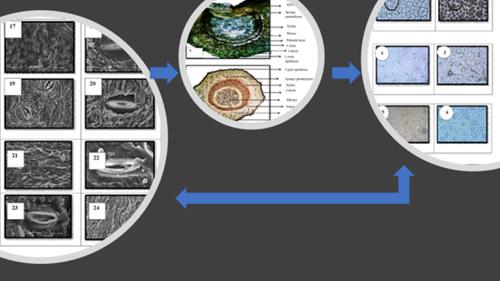当前位置:
X-MOL 学术
›
Microsc. Res. Tech.
›
论文详情
Our official English website, www.x-mol.net, welcomes your
feedback! (Note: you will need to create a separate account there.)
Foliar micromorphology and its role in identification of the Apocynaceae taxa.
Microscopy Research and Technique ( IF 2.0 ) Pub Date : 2020-03-02 , DOI: 10.1002/jemt.23466 Kalsoom Bashir 1 , Aamir Sohail 2 , Usman Ali 1 , Asad Ullah 1 , Zahoor Ul Haq 3 , Brekhna Gul 4 , Inam Ullah 5 , Sunera 6 , Mehrina Asghar 7
Microscopy Research and Technique ( IF 2.0 ) Pub Date : 2020-03-02 , DOI: 10.1002/jemt.23466 Kalsoom Bashir 1 , Aamir Sohail 2 , Usman Ali 1 , Asad Ullah 1 , Zahoor Ul Haq 3 , Brekhna Gul 4 , Inam Ullah 5 , Sunera 6 , Mehrina Asghar 7
Affiliation

|
In the present study, we evaluate the importance of foliar epidermal micromorphological characteristics of Apocyanaceae for accurate identification and classification. The species were collected from the University of Peshawar's main campus in the spring season to observe its qualitative and quantitative features. The length and width of guard cells, stomatal pore and subsidiary cells, trichomes, and crypts on both sides of the leaf were examined. Many species were observed to be hypostomatic. Plumeria rubra, Raulfia serpentine, Thevetia peruviana, Trachelospermum lucidum, Alstonia scholaris, and Catharanthus roseus demonstrated hypostomatic leaves. Nearly all the investigated species had anisocytic type of stomata only or in combination with other types of stomata on the upper and lower epidermis. Carissa carandas had anomocytic, anisocytic, and cyclocytic type of stomata on the upper epidermis, and the lower epidermis showed variations in stomatal type, such as anomocytic, stephanocytic, brachyparacytic, and hemiparacytic. Nerium oleander had no specific shape of stomata but showed stomatal crypts in which the stomata were enclosed inside many trichomes. The taxonomic key based on stomatal types, epidermal cells, stomatal index value, and statistical analysis, along with the variations in the epidermal cells, shows the link between the selected plants species, which will provide a baseline for future anatomical studies. This study highlights many undocumented micromorphological characteristics. The anatomical characteristics observed in this study will be helpful for taxonomic identification and species delimitation of the family Apocynaceae.
中文翻译:

叶微形态及其在夹竹桃科分类中的作用。
在当前的研究中,我们评估了正确的识别和分类的杜鹃花的叶表皮微形态特征的重要性。该物种在春季从白沙瓦大学的主校区收集,以观察其定性和定量特征。检查了叶片两侧保卫细胞,气孔和附属细胞,毛状体和隐窝的长度和宽度。观察到许多物种是假说的。鸡蛋花,Raulfia蛇纹石,黄花peruviana,络灵芝,灯台树,和长春花表现出气孔叶片。几乎所有被调查物种仅在上表皮和下表皮上具有异型气孔或与其他类型的气孔组合。Carissa carandas在上表皮上有气孔,异种和环胞型气孔,而下表皮气孔类型有变化,如无气孔,单核细胞,近胎和半胎。夹竹桃没有特定形状的气孔,但有气孔隐窝,其中气孔被封闭在许多毛状体中。基于气孔类型,表皮细胞,气孔指数值和统计分析以及表皮细胞变化的分类关键,显示了所选植物物种之间的联系,这将为将来的解剖学研究提供基线。这项研究突出了许多未记录的微观形态特征。在这项研究中观察到的解剖学特征将有助于夹竹桃科的分类学鉴定和物种划分。
更新日期:2020-03-02
中文翻译:

叶微形态及其在夹竹桃科分类中的作用。
在当前的研究中,我们评估了正确的识别和分类的杜鹃花的叶表皮微形态特征的重要性。该物种在春季从白沙瓦大学的主校区收集,以观察其定性和定量特征。检查了叶片两侧保卫细胞,气孔和附属细胞,毛状体和隐窝的长度和宽度。观察到许多物种是假说的。鸡蛋花,Raulfia蛇纹石,黄花peruviana,络灵芝,灯台树,和长春花表现出气孔叶片。几乎所有被调查物种仅在上表皮和下表皮上具有异型气孔或与其他类型的气孔组合。Carissa carandas在上表皮上有气孔,异种和环胞型气孔,而下表皮气孔类型有变化,如无气孔,单核细胞,近胎和半胎。夹竹桃没有特定形状的气孔,但有气孔隐窝,其中气孔被封闭在许多毛状体中。基于气孔类型,表皮细胞,气孔指数值和统计分析以及表皮细胞变化的分类关键,显示了所选植物物种之间的联系,这将为将来的解剖学研究提供基线。这项研究突出了许多未记录的微观形态特征。在这项研究中观察到的解剖学特征将有助于夹竹桃科的分类学鉴定和物种划分。











































 京公网安备 11010802027423号
京公网安备 11010802027423号